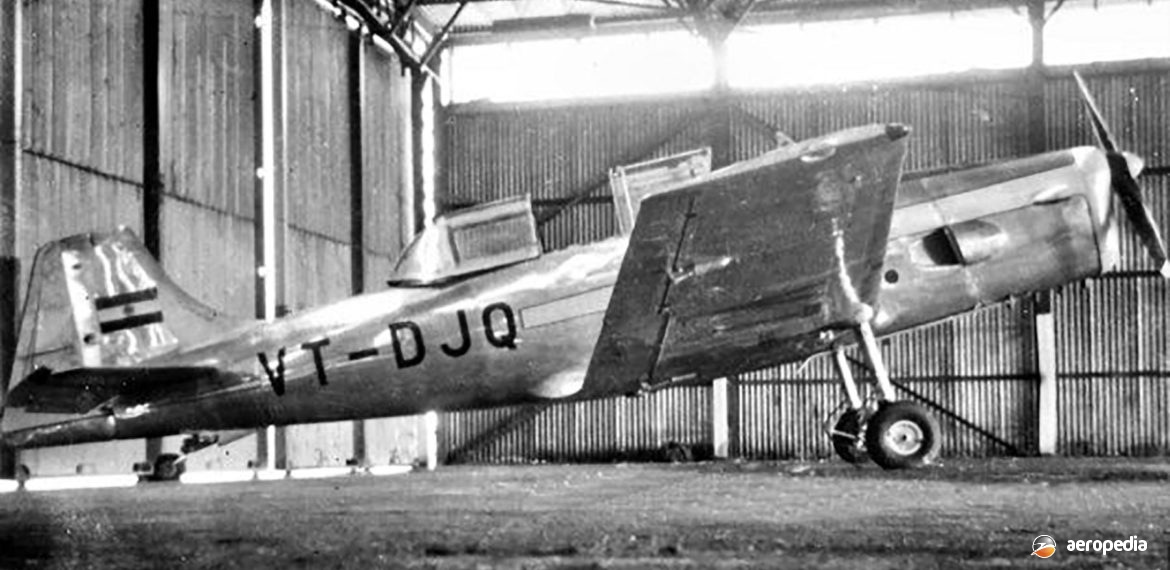Photograph:
Hindustan HT-2 VH-AWL as VT-DJQ (c/n T-111) at Moorabbin, VIC in 1958 (Eddie Coates collection)
Country of origin:
India
Description:
Two-seat light civil and military trainer
Power Plant:
One 116 kw (155 hp) Blackburn Cirrus Major Series III four-cylinder in-line air-cooled engine
Specifications:
- Wingspan: 10.72 m (35 ft 2 in)
- Length: 7.68 m (25 ft 2½ in)
- Height: 2.72 m (8 ft 11⅓ in)
- Wing area: 16.1 m² (173.4 sq ft)
- Max speed: 209 km/h (130 mph)
- Cruising speed: 185 km/h (115 mph)
- Initial rate of climb: 244 m/min (800 ft/min)
- Service ceiling: 4,420 m (14,500 ft)
- Absolute ceiling: 5,029 m (16,500 ft)
- Range: 563 km (350 miles)
- Endurance: 3.5 hours
- Empty weight: 699 kg (1,540 lb)
- Loaded: 1,016 kg (2,240 lb)
History:
The HT-2 was designed by Dr V M Ghatge, Chief Designer of Hindustan Aircraft Ltd (HAL) at Bangalore, India. It was the first powered aircraft to be designed and built completely in India, and was built in some numbers for the Indian Air Force and the Indian Naval Air Arm. It was also supplied to Indian Civil Aviation Establishments and aero clubs, a total of 166 being completed. In addition, it was made available for export to civil and military organisations; and one was supplied to the Indonesian Air Force.
Design work on the project began in 1948 and by August 1949 a mock-up had been completed. It was examined by the Directorate General of Civil Aviation and staff of the Indian Air Force; and, whilst the design was basically accepted, some changes were made. The construction of the prototype proceeded, the wings and fuselage being mated in May 1951.
The prototype (VT-DFW) was flown for the first time in a private flight for design and construction staff on 5 August 1951, making its official first flight on 13 August 1951, being fitted with a 108 kw (145 hp) de Havilland Gipsy Major 10 engine. The second prototype (VT-DFY), which first flew on 19 February 1952, was different in a number of respects, changes including a re-designed cockpit canopy, re-design of the fin and rudder to increase the chord, and the installation of the Blackburn Cirrus Major III engine in this and production aircraft. Production to meet an order for 100 aircraft commenced in 1952.
The HT-2 was cleared for instructional duties with the Indian Air Force but the prototype was lost when the pilot escaped after failing to recover from a spin. The first three aircraft were delivered to Begumpet airfield (Hyderabad) in 1955 for Pilot Instruction Course No 68, the HT-2 taking over from the Percival Prentice trainer which had been built by HAL under licence.
By the early 1980s the Cirrus Major engine could not be supported as there was a shortage of spare parts and a Lycoming engine was installed in one (IX494), becoming the HT-2L. However, it was not a successful transformation and only one aircraft was modified, the HT-2 series being retired in 1989 after 34 years of service, being replaced by the HPT-32.
The HT-2 was exported to Ghana, twelve being delivered for training work. However, it was not successful there and, due to lack of parts and poor logistic support, most were scrapped. However, it is known that at least two of these made their way to South Africa and were later offered for sale as restoration projects.
One example was imported to Australia and made a demonstration tour in June 1958 (VH-AWL – c/n T-111 – ex VT-DJQ). Flown by Flt Lt Sunandan Roy, a company test pilot, it was demonstrated to the Royal Australian Air Force (RAAF) and a number of flying clubs in Sydney, NSW, Melbourne, VIC, Adelaide, SA and Brisbane, QLD. One of the aerobatic demonstrations involved an eight-turn spin followed by cloverleaf loops at low level, with steep turns and slow rolls in a reciprocal direction. In Brisbane the demonstration was commenced at too low a height. The aircraft hit the ground and was extensively damaged, the pilot receiving injuries.
VH-AWL was registered on 25 June 1958 and, after the accident, was returned to India for a rebuild, being struck off the register on 13 October 1960, but was scrapped. A replacement aircraft was shipped to Australia and made a sales tour but by that time Royal Air Force (RAF) surplus Chipmunks were becoming available to aero clubs and the HT-2 did not receive any orders. This aircraft was later returned to India and did not receive an Australian registration.
The HT-2 was of all-metal construction and had full standard basic training equipment, and night and blind-flying equipment.
A total of 22 examples of the HT-2 has survived in India at various locations, including the Air Force Academy at Bidar, The Heritage SWAC Museum at Jodhpur, Air Force Administrative College at Coimbatore, Indian Air Force Museum, Naval Air Museum, etc. One civil machine (VT-DFY) has survived at the Department of Aero Science at Bangalore. None is known to be airworthy.

